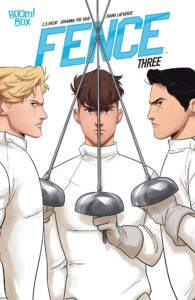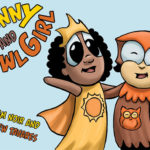
Fence #3
Publisher: Boom! Box
Writer: C. S. Pascat
Artist: Johanna the Mad
Colors: Joana Lafuente
Letterer: Jim Campbell
Review by Laura Forsey
 C. S. Pascat’s love of fencing and desire to share it with others shines through every moment of Fence #3. If Fence #1 introduced us to Nicholas, and #2 brought us to Kings Row boarding school and a broad cast of characters, then Fence #3 is the reader’s proper introduction to the sport itself. Sports-focused stories are historically more common in Japanese manga, which Pascat cites as a direct influence on her work, than in Western comics. The ones that do exist tend to suffer from a common problem: assuming that the reader is familiar with the sport and its jargon. For a new reader who may not know what a bank shot or a zone blitz are, that can make the comic feel inaccessible. Fence handily addresses this issue by making its protagonist, Nicholas Cox, a relative newcomer to the sport. In correcting Nicholas’s poor technique, Coach Williams gets a chance to teach the reader a few essential fencing terms.
C. S. Pascat’s love of fencing and desire to share it with others shines through every moment of Fence #3. If Fence #1 introduced us to Nicholas, and #2 brought us to Kings Row boarding school and a broad cast of characters, then Fence #3 is the reader’s proper introduction to the sport itself. Sports-focused stories are historically more common in Japanese manga, which Pascat cites as a direct influence on her work, than in Western comics. The ones that do exist tend to suffer from a common problem: assuming that the reader is familiar with the sport and its jargon. For a new reader who may not know what a bank shot or a zone blitz are, that can make the comic feel inaccessible. Fence handily addresses this issue by making its protagonist, Nicholas Cox, a relative newcomer to the sport. In correcting Nicholas’s poor technique, Coach Williams gets a chance to teach the reader a few essential fencing terms.
Throughout Fence #3, we learn more about both Nicholas and the world he has thrown himself into. Because of his background, he struggles to adjust to the boarding school lifestyle that his friends and potential teammates take for granted. Students like Bobby, for example, can deviate from the norm because they know which rules are flexible and which are not. A skirt and ponytail are fine, as long as you don’t wear a sweater when you should have a rugby shirt- or vice versa! Despite his late start, Nicholas’s determination to earn his place on the team and at King’s Row shine through. His will to succeed drives him to practice at the crack of dawn, to keep improving himself rather than relying on natural ability, and to get back up when he fails. It’s what makes us want to see Nicholas succeed, and what makes both Coach Williams and Seiji Katayama take notice of him.
Just like Pascat’s writing, Johanna the Mad’s art is clear and bold. Movement is hard to convey in any comic, but in a fast-paced sport like fencing, it becomes crucial to the story itself. Fence’s strong lines, expressive body language, and simple but natural colours (by Joana Lafuente) give a nod to creative influences like Check Please or Yuri!!! on Ice while still feeling like their own entity. The cast of characters is especially diverse and interesting in terms of both looks and personality. Although I especially loved Bobby’s look, the bright green sweater did make him stand out far more than the other characters, and drew some of the attention away from main characters like Nicholas and Seiji. Still, each of the characters and their designs feels unique and rich with potential. I can’t wait to see what parts each of these boys will play in the story once the team is finalized.
Verdict:
Buy it! Like Nicholas, Fence is a newcomer, but it has the determination and the raw talent to go far. As it’s only on issue 3, so there’s plenty of time to jump on and catch up. This story has the potential to become another of Boom!’s compelling, engaging all-ages comics.


![[PODCAST] THE COMICS AGENDA: INTERVIEWING FRANK GOGOL](https://geekd-out.com/wp-content/uploads/2017/10/comics-agenda-banner-150x150.jpg)
